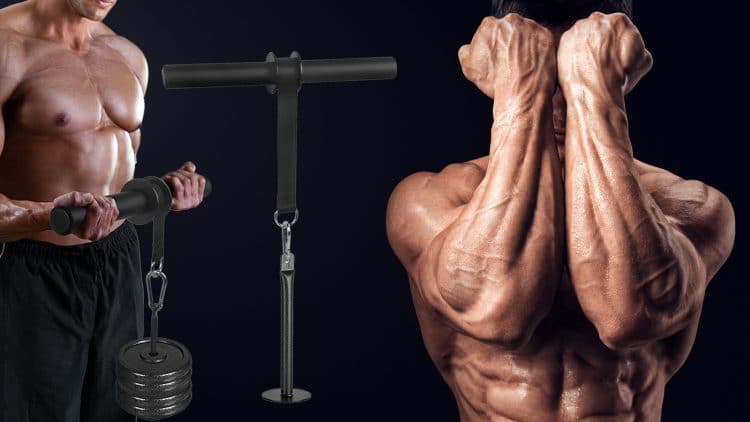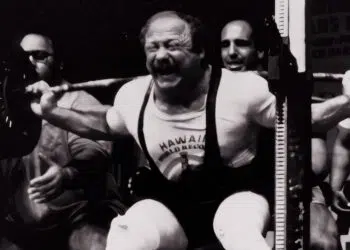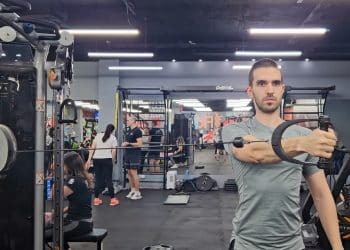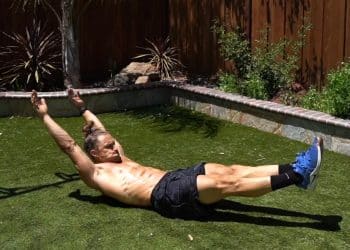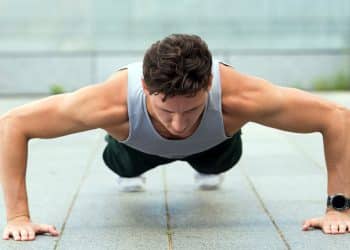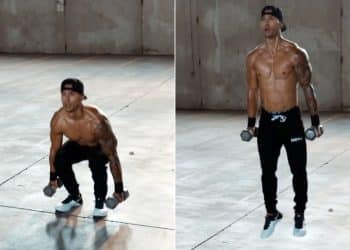Have you ever been to one of those palm readers before? Maybe got some insight and interesting predictions about your life. Well, what if we told you that your grip could show us into your future too?
How can that be?
Well, in several recent studies, researchers have found significant evidence to suggest your grip strength can predict several markers of physical and mental health as well as early all-cause mortality (1). Regardless of adult age! Yeah, that’s pretty scary, and all the reason to start not just building your squeezing power but total body strength too!
Having a capable grip is an underrated, but essential aspect of daily tasks and physical performance. We use the power in our hands every day to do many things that you probably took for granted until now.
We’ll go more into that momentarily but first, we’d like to bring your attention to a unique finger-focused grip-strengthening exercise called the plate pinch. An isometric lower arm and hand building variation holding (No pun intended) several advantages over other similar grasp strengthening methods.
So let’s dig into it!
Level Up Your Fitness: Join our 💪 strong community in Fitness Volt Newsletter. Get daily inspiration, expert-backed workouts, nutrition tips, the latest in strength sports, and the support you need to reach your goals. Subscribe for free!
Muscles Worked During The Plate Pinch
What part of the body do you use to pinch something? Your fingers of course. Well, there are muscles that move, contract, and allow you to do that, found in the hand, and forearm. Let’s talk about those muscles and the others used during the plate pinch.
Arms and hands
There are 35 muscles that move your hand and forearm, which are divided into two categories of fibers, flexors and extensors. They run like cables from the forearms, through the wrists, and into the hands where they attach to tendons in the fingers which allows us to squeeze and open the hand.
It’s important to note that there are no muscles in the fingers, just bones, tendons, ligaments, connective tissues, blood vessels and nerves. And unlike muscles, they take longer to adapt to resistance loads, and are hence more susceptible to injuries if you add too much weight too quickly.
But the fingers do play a massive role in grip related activities.
Building a powerful grip requires patience, and slow, steady progress.
Here are brief descriptions of grip muscle functions.
- Extensors – To enable a full strength grip with your fingers, the wrists need to be somewhat extended to stabilize the wrists.
- Flexors – These are the muscles that squeeze and let us grip objects.
Here’s an entertaining and educational video lesson on the anatomy of your grip, if you’re interested and have a few spare minutes to watch.
Full body
We’ll make this one quick cause there’s not much to see here folks. But the plate pinch should start off as a deadlift which engages every muscle from those in the feet, to the legs, glutes, core, back, shoulders, and neck.
Then when you’re standing in one pose and holding the plates, those mentioned muscles shift into cruise mode where they’re only engaged isometrically (Stationary, no contraction of lengthening).
How To Do The Plate Pinch
For this exercise, you’ll need at least one weight plate without handles that allow you to get a full finger wraparound grip. We recommend using the soft coated plates with the standard center hole for sliding it onto a bar.
You’ll also need to understand basic deadlifting technique to safely pick up the weights. This is essentially maintaining a straight back, tensing your abs, and lifting with your legs, not your back.
Steps
- Use proper lifting technique to pick up your weight plates, or roll them to the desired spot where you’ll perform the exercise.
- Start from a bent-over deadlift position while balancing the weight plates on the floor in your hands. Squeeze or pinch the plates with a full grip using all fingers and your thumbs.
- Stand up, keep your shoulders back, tense your abs, and arms, and simply squeeze the weights for 10-20 seconds or until your grip feels tired. From here you can determine if the weight is too light or heavy.
- When you’re finished, squat down and place the weight on the floor.
- Take a minute rest and repeat.
For your convenience, here’s a video demonstration of the plate pinch.
Pro Tips
- There are two common ways to make plate pinches more challenging. Obviously you can grab heavier plates, or grab more than one plate in your hand.
- If possible, we recommend using urethane-coated bumper plates which are good for gripping and if you have to drop the weight, they’re safer for the floor and you.
- Choose a weight that allows you to maintain a grip for a minimum of 10 seconds per hold.
- Always be mindful of maintaining safe lifting technique when picking up, transporting, and setting the weights down.
- Try not to move and squirm around during your sets as it could contribute to muscles imbalances due to the potential for uneven movement, and muscle compensation.
- Wear lifting gloves if it helps prevent the weight from slipping.
- Avoid curling your wrists.
Benefits of The Plate Pinch
Plate pinches offer their own unique benefits, but even without that, building a stronger grip is necessary for so many reasons.
Unique Finger Focused Grip Exercise
Unlike wrist curls and those hand gripping tools found in every variety store, plate pinches train the gripping muscles differently, and in my opinion, potentially more safely. Especially if you’re letting the weight roll onto your fingers during wrist curls which isn’t good for them or your elbows.
During plate pinches, the weight is not loaded directly, and downward onto the finger bones, but rather you’re squeezing and holding the weight up against gravity with tips of your fingers and thumbs, activating more muscle strength and arm tension.
And while there are no muscles in the fingers, there are tendons and other contents that adapt to strength training, albeit, at a slower rate than muscles, as mentioned above. So while the hands, containing the residual muscles from forearms contribute more to gripping power, the fingers are important hooks during exercises.
Oftentimes, the muscles don’t give out when training, it’s the grip. So tighten up on your clench, and lock the weight in with the strength of a coconut crab!
May Help You Live Healthier and Longer
According to an article by Harvard, one study tested and monitored the grip strength of roughly 140,000 people over a four-year span. What they found was that for every 11-pound strength decrease in grip strength, there was a 16 percent higher risk of death, 17 percent higher potential for heart disease, as well as a six and seven percent increased risk of stroke and heart attack, respectively.
Moreover, a weak grip can increase the likelihood of developing common chronic diseases such as Type II diabetes, cancer, etc.
But what was just as alarming was that the correlation between grip and the aformentioned health factors remained consistent despite different variables, like age, for instance.
In fact, researchers were convinced that grip strength is a more accurate method to assess your biological age, rather than solely looking at one’s chronological age (How old you are in years) which doesn’t always tell the whole story. As the two can be different.
“People who maintain their grip strength age more slowly. They stay healthier longer and are stronger throughout their bodies”, explained geriatric medicine specialist Ardeshir Hashmi, MD.
So whether you’re a younger or older adult, you should be engaging in weight-bearing activities. A weak grip is bad news for all adult age brackets.
And the cherry on top, another study showed accelerated aging in the DNA of its participants with weaker gripping strength (2).
Plate pinches are a low intensity, beginner friendly way to start building up your grip, while challenging the arms and engaging other muscles, which in turn can help build and maintain strength.
Strengthen Mental Grit Too
It’s not a secret that life can be extremely challenging. And oftentimes the answer is to do things that are challenging but rewarding. This can help us not just to be mentally stronger, but it’s one way to discipline ourselves, which carries over into other endeavors.
Building mental fortitude gives you the strength to keep going, snap out of a rut, and take on those difficult situations. Yes, it may seem like a motivational speech, however, it’s one of the potential benefits of this grip training variation.
Grip Strength is a Basic Human Necessity
From opening a water bottle or jar to turning on the water hose, buttoning your pants, carrying items, and engaging in basic body strengthening activities, you’re pretty limited without a capable grip.
We’re not saying you need to train your grip like a maniac to continue performing these basic tasks. But maintaining strength is important, and it does correlate to well-being, injury prevention, and according to research how long you’ll live.
Plus, plate pinches are a form of total body isometric resistance training which is one of the two most common muscle and strength building techniques.
Common Mistakes During The Plate Pinch
Without a proper understanding of what we’re trying to accomplish with the plate pinch, you can quickly lose your grip (Pun intended) on its potential, and possibly cause more harm than benefits. Let’s see what those mistakes look like…
Level Up Your Fitness: Join our 💪 strong community in Fitness Volt Newsletter. Get daily inspiration, expert-backed workouts, nutrition tips, the latest in strength sports, and the support you need to reach your goals. Subscribe for free!
Using Plates with Handles, aka Cheating
So while you could use those weight plates with handles for easy gripping and it’s one way to fortify your hand strength, that’s not the point. We don’t want the fingers wrapped around but rather pinching the weights for a more finger-focused variation.
Not Deadlifting The Weight Up
You should start with the bottom of the weight plate on the floor and the top in your grip while in a deadlift position. Never just bend over and pick the weight up. Why? Because you should always practice safe lifting habits, and be intentional.
Use your legs and the power of proper deadlift technique to pick up the weight.
Slipping on Your Form
While it’s true you’re just holding the plates without movement, your posture and body need to be appropriate, to support the weight without stressing your shoulder joints, traps, spine, etc. Simply follow the plate pinch instructions included above to do it right!
Gripping and Slipping
If the plates are constantly slipping out of your hands, there’s no viable way to do this exercise asymmetrically between your left and right side. One hand may be stronger than the other, but you’re just creating a mess if your setup is not appropriate to train both sides equally.
Either use the proper plates with non-slip coating, lower the weights, or get a pair of gloves to prevent your hands from slipping.
Otherwise, you’ll be fighting to keep the weights in your grip with fingers slipping, and your body compensating, creating imbalances over time.
7 Variations and Alternatives Of The Plate Pinch
You’d be surprised at how many ways you can hold a weight plate, or the techniques you can do. So we’ll show you some of those plus the best alternative methods to build a crushing grip.
Plate Pinch and Carry
Like a farmer’s walk but with a half grip, the plate pinch and carry is what its name suggests, you simply walk with plates in hand.
What is the benefit of a walking plate pinch?
Well it’s quite simple, when you introduce movement, the grip muscles have to work harder to hold the plates. More effort goes into stabilizing the arms when you’re walking, plus you have to focus more with this variation.
You’ll also learn to develop more functional grip strength in a more unstable environment (Walking motion).
Plate Flip and Catch
We wanted to toss (Pun intended) this one in the mix too, because it is technically a plate pinching variation but with a crazy side.
You’ll definitely need to use lighter soft coated plates and appropriate flooring (Or head outdoors on grass) as you’ll be letting go of the plate entirely before catching it in mid air over and over again. The key is to time your flips perfectly so that you can grab it in your hand without dropping it.
The plate flip and catch adds a more dynamic element to grip training that also challenges your coordination and several functional abilities, while improving your reflexes and certain mental aspects of performance.
Pro Tips:
- Make sure to use your legs and not your back when catching and flipping the plate.
- Keep your core muscles tense to protect your back and create efficient transfer during the plate toss.
- Don’t wear open toed shoes, unless you want some real problems.
Check out a demonstration of the plate flip and catch via the following video.
Farmer’s Walks
The farmer’s carry is a popular Strongman workout and competition event where the athlete walks for distance while holding two long and heavy implements with bar style handles attached. It’s one of the most recommended grip building techniques, and you can use any type of weights, whether dumbbells, kettlebells, a trap bar, etc.
I wrote a full guide on farmer’s walks right here.
Thick Bar Exercises
Regardless of the exercise, you can use a fat or thick bar that fills up more of your grip. How will that increase your squeezing strength?
For one you’ll have to work a little harder to maintain the bar in your hand, but you’ll need to shift your mental motors into a higher gear as well.
Fat grip training guide: Benefits, exercises, dos and don’ts.
Hand Grippers
These things have been around forever and we promise many of you were obsessed with them at one point (Guilty as charged).
Sold in most variety stores, they’re no gimmick speaking from personal testing, and what I found from taking on the hardest metal grippers was they’re a fun way to challenge friends and family to see who has a stronger grip. Boys will be boys, right?…
Well, you can find hand squeezers in just about every resistance level for anyone from the absolute beginner, to the elder person, or the most extreme beasts that live among us! You can also choose ones covered in foam, made of hard plastic, or straight up aluminum and metal.
But one issue with these grippers is that people often use them as the only method to strengthen their clamping power. You should be combining techniques for best all around results.
Also, if you’re using the heaviest grippers, don’t it everyday as it can place a lot of stress on the fingers and hands.
Here’s our write up on these useful gadgets that includes how to use them and all their benefits.
Finger Extensions
In the plate pinch, your objective is to squeeze the weight so that it doesn’t fall from your grip. With finger extensions, your goal is to open your hand against the resistance of a rubber band.
Most gripping moves focus on clamping down or squeezing, but what about the opposite? After all, the muscles in your hands can both close and open which requires different muscles.
Related: How to build a stronger grip at home.
Wrist Rollers
A good old fashioned grip building method, wrist rollers can be purchased or easily engineered with items you already have lying around the house, like thick plastic tubing, a drill to make a hole, a long piece of durable strap-like material, and a weighted object.
But there are simpler ways to construct a wrist roller at home which we explained in detail in this wrist roller training guide.
FAQ’s
How long should I hold the weights for to build a stronger grip?
Don’t focus so much on the time, instead place your efforts in ensuring you’re using the appropriate resistance while being able to grip the plates evenly without them slipping.
As we mentioned, you should opt for the bumper style plates, or wear gloves. Just don’t let the weights slide toward the ground during your sets. Then when you got the setup and proper technique down pat, you can start timing yourself against the weight loads! Progressing in weight.
Where does the plate pinch rank among the best grip strengthening exercises?
While it’s true your forearms and hands contain the gripping muscles, the unique open grip style of plate pinches can help to strengthen the tendons and other material in your fingers for better gripping power since the fingers do play an important role in supporting weight bearing actions.
This is different than say wrist curls or farmer’s walk where the palms support a lot of the weight. Overall, plate pinches are useful in their own way, not used for building massize gripping power but emphasizing the role of your fingers and hands in gripping activities.
Wrapping Up
Well, if that information wasn’t a wakeup call, then we don’t know what would constitute one. Knowing just how vital grip strength is to health and well-being isn’t something everyone knows by default. After all, you could just be weak, right? Well, don’t rely on that method of thinking.
Hopefully now you have a newfound reason to start incorporating more grip training in your workouts, and the plate pinch is definitely worthy of your attention.
With all the compelling research out there, yesterday was the best time to start training, and the second best is right now. For the sake of your long term health, well-being, and living longer!
References:
- Bohannon RW. Grip Strength: An Indispensable Biomarker For Older Adults. Clin Interv Aging. 2019 Oct 1;14:1681-1691. doi: 10.2147/CIA.S194543. PMID: 31631989; PMCID: PMC6778477.
-
, , , , and (2023) Grip strength is inversely associated with DNA methylation age acceleration, Journal of Cachexia, Sarcopenia and Muscle, 14, 108–115.
Interested in measuring your progress? Check out our strength standards for Wrist Curl, Deadlift, Squat.

